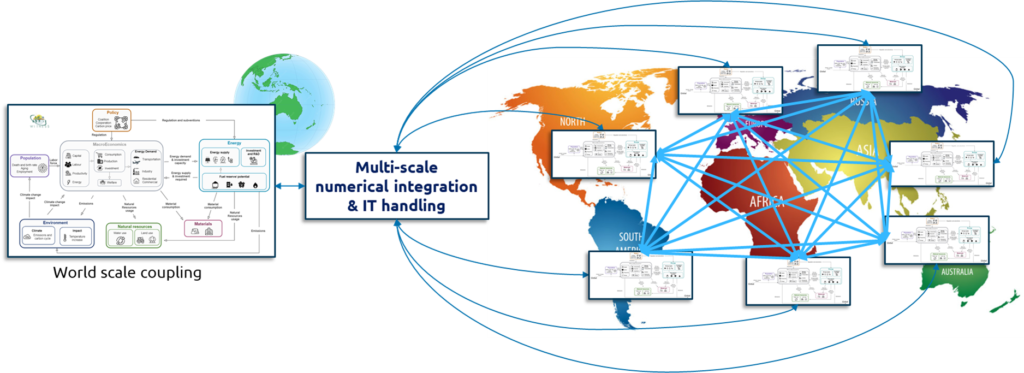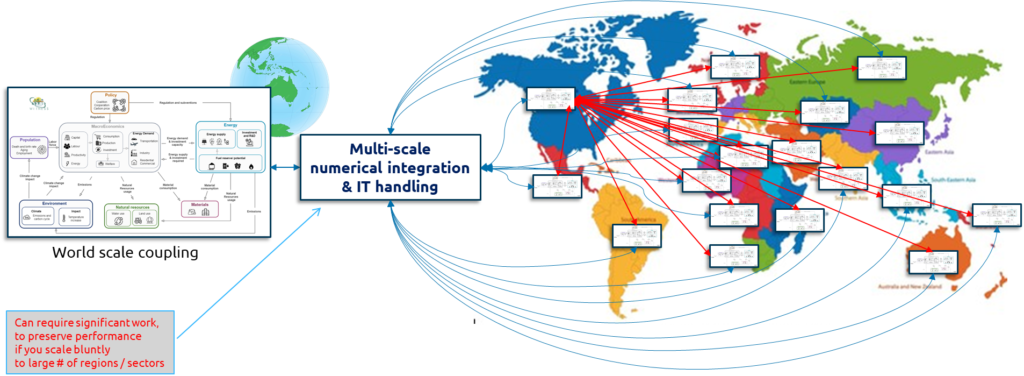We start adding sectorization and regionalization in WITNESS, and here is a sneak preview of what we plan…
The issue
There are today 2 main ways to address decomposition of the world system into subsystems
| Macro-economy Study and model economy as a whole, with focus on the performance e.g. inflation, economic growth, unemployment… ●Strengths ○ understanding how the economy works as a whole ○ understanding how different sectors interact with each other ○ can simulate policy makers decisions about monetary and/or fiscal policy and how it affect the overall performance of the economy ●Weaknesses ○limited by its focus on aggregate data and its inability to capture the complexity of individual behavior / sectors / regions White box approach, more transparent and can be examined more closely because based on theoretical models that attempt to explain how the economy works => Easier to modify to include shocks, tipping points effects… as you know where to add it Examples : MEDEAS, CSE, WITNESS… (non exhaustive list !) | Econometry Application of statistical methods to economic data , with focus on analyzing/estimating relationships between economic variables (any you might have) ●Strengths ○can test economic theories / hypotheses using empirical data ○ can identify causal relationships between different economic variables and estimate the magnitude of these relationships ●Weaknesses ○limited by its reliance on assumptions about the underlying data generating process ○inability to capture all or new relevant factors that may affect economic outcomes Black box approach that rely on statistical methods to estimate relationships between variables without necessarily understanding the underlying mechanisms that generated them => More difficult to include shocks, tipping points effects… as you don’t know where to add it Examples: Oxford economics GEM, IHS MarkInt, S&P Global GLM… (non exhaustive list !) |
As mentioned above, WITNESS is today fully on the macro-economy side, with the associated advantaged and drawbacks
| Today, WITNESS is world global model only so our starting point for regionalization / sectorization is 1 region = world, 1 sector= all economy |  |
| To sectorize or regionalize, you need both to consider the subsystems of your global system as independent models of each subsystem – that are interfaces between each other, and to reconciliate some quantities globally as they can’t be localized or sectorized. Typically resources consumption or energy production can be split by subsystems, but CO2 emissions and some climate damage effects such as ocean rise or temperature increase need to be reconciled globally (even if their effects can be different for each of the considered subsystem e.g. Oceania more concerned by ocean level rise than Africa) |   |
| This strategy should allow to have smart high level regionalization into 6~9 macro-regions, and high level sectorization into 4~5 big sectors. |  |
| However, pursuing this “modeling brute force” strategy, let’s say for example to 195 countries and the 615 NACE sectors, would end up in 195*615 = 119 925 models to be developed… |  |
The “smart” strategy
We therefore want to develop a strategy that allows mixing macro-economy modeling of the sub-systems we think needs it because we want there to simulate non-linear behaviors (e.g. shocks, economy, climate or policy tipping points…), with an econometric “rest of the sub-systems” approach following global linear regression evolution (or polynomial at best).

We intend to develop that in the coming year, with a first high level sectorization prototype available end’23 and a first high level regionalization available together with the smart sectorization/regionalization methodology & tooling by summer’24…